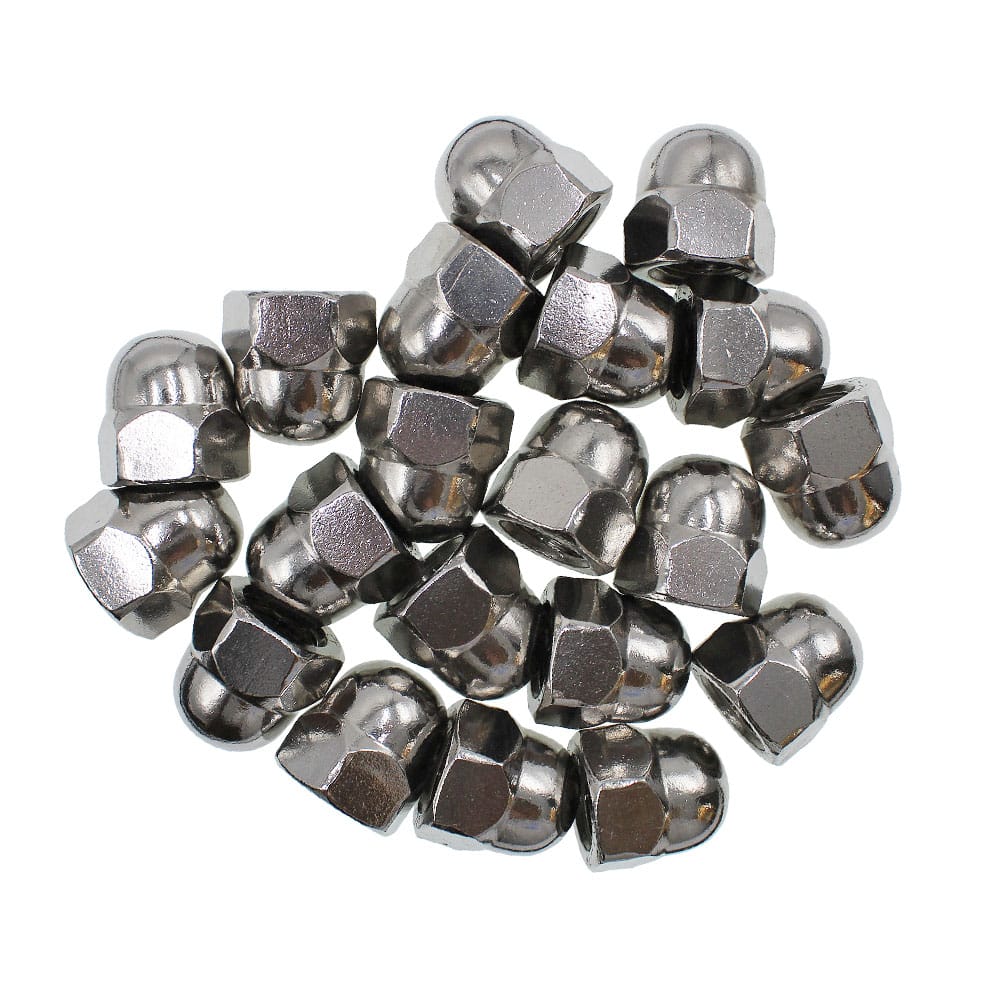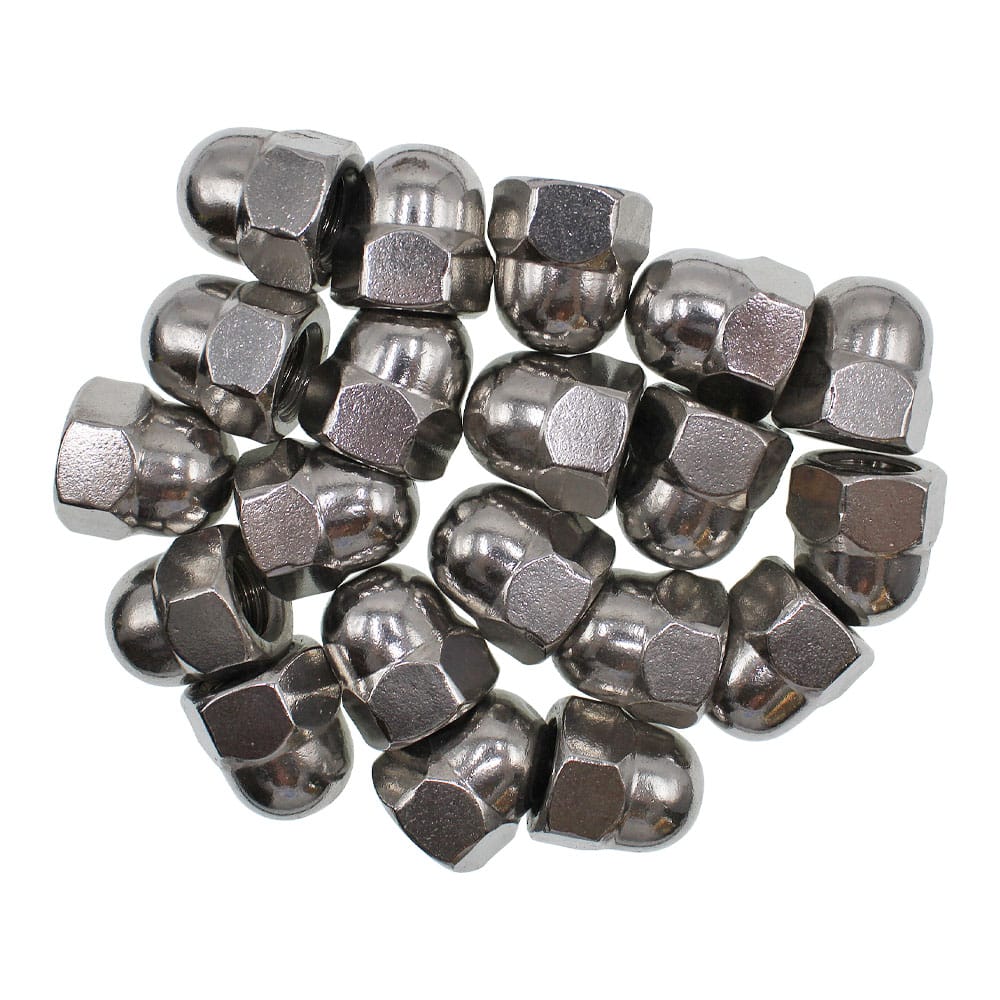- Massive Range
- FREE UK Delivery
- Rapid Dispatch
- Massive Range
- FREE UK Delivery
- Rapid Dispatch
- Massive Range
- FREE UK Delivery
- Rapid Dispatch
£10.99 – £107.25 inc VAT


This website is secured:
£ MULTIBUY SAVINGS – Order 3 For 10% Off
✔ Specialists In Rapid Shipments Of Any Size
✔ FREE UK Delivery Included
✔ Immediate Express Dispatch From Stock
✔ Tracked Delivery with Order Updates
✔ 30-Day Returns Accepted
@ ☏ Larger Pack Quantities Available
If you’re looking for a reliable and long-lasting solution to secure your equipment, look no further than the M14 (14mm) A2 Stainless Steel Dome Head Nut by Speciality Metals. This dome head nut is made from 304 grade stainless steel, ensuring durability and corrosion resistance that will keep your gear secure for years to come. It’s versatile enough to fit a variety of applications, and its low maintenance means you won’t have to constantly fiddle with it. So go ahead, invest in the secure peace of mind that comes with the M14 dome head nut by Speciality Metals.

This top quality stainless dome head nut is supplied straight from Warrington, UK.
A2 Stainless Steel Dome Head Nut M14 (14mm) is an excellent choice for those who are looking for a durable and versatile fastener with low maintenance requirements. With 304-grade stainless steel construction, this nut is designed to withstand harsh weather conditions, making it an excellent choice for outdoor applications. The dome head design ensures a snug fit and provides a smooth finish, adding an aesthetic touch to any project. In addition, the corrosion-resistant properties of the nut make it an excellent choice for marine and industrial applications. With Speciality Metals’ products, you can be sure of their quality and reliability. The M14 dome head nut is an excellent investment for those seeking a long-lasting and secure fastener.
Standard nuts are not as aesthetically pleasing as dome nuts.
Key product details:
Speciality Metals are the best suppliers for you because:
Speciality Metals is a trusted UK based distributor of fasteners, sheet metal, flat bar and round tube. We specialise in rapid delivery to any location around the country. Our team of experienced, friendly staff are at hand at all times to process your order.
Appearance: Dome nuts have a rounded or “domed” cap over one end, giving them a finished and aesthetically pleasing appearance. The dome also helps to protect the threads and the end of the bolt from environmental exposure.
Material: Often made from Stainless Steel 304 or other corrosion-resistant materials, making them suitable for applications that require a polished look or corrosion resistance.
Mechanical Locking: Dome nuts generally rely on the mechanical fit between the threads of the bolt and the nut for locking. They don’t have an inherent locking mechanism to prevent loosening due to vibration.
Applications: Commonly used in applications where appearance matters, such as furniture, architectural projects or exposed machinery parts.
Appearance: Nyloc nuts look like standard hex nuts but have a nylon insert at one end.
Material: Can be made from a variety of materials, but the key feature is the nylon insert that provides a locking mechanism.
Locking Mechanism: The nylon insert provides resistance when threaded onto a bolt, preventing the nut from loosening due to vibration or other dynamic forces. This makes Nyloc nuts effective in applications where vibration is a concern.
Applications: Commonly used in machinery, automotive applications and other situations where the fastener is subject to vibration or dynamic loads.
Temperature Limitation: The nylon insert has temperature limitations. If exposed to high temperatures, the nylon can deform or melt, compromising its locking capability.
Stainless Steel 304 dome nuts can be utilised for underwater applications, but their suitability depends on various factors such as the type of water, depth and potential for chemical exposure. While Stainless Steel 304 offers good general corrosion resistance, it is not the best choice for saltwater or chloride-rich environments due to its susceptibility to pitting and crevice corrosion. For such conditions, more corrosion-resistant materials like Stainless Steel 316 are often recommended. Additionally, the pressure increases with depth underwater, so the dome nuts need to be rated for the specific pressures they will encounter. Stainless steel can also gall when in direct contact with itself under pressure, so the use of anti-galling lubricants may be necessary. Given these considerations, especially for critical or long-term underwater applications, consulting with engineers for material selection and conducting regular inspections for signs of wear or corrosion are advisable steps to take.
Stainless Steel 304 dome nuts can be susceptible to stress corrosion cracking (SCC) under specific conditions, particularly in environments that are rich in chlorides, such as saltwater, and in situations where the material is subjected to tensile stresses. While Stainless Steel 304 offers good general corrosion resistance, it is not as resistant to SCC as some other grades of stainless steel, such as Stainless Steel 316. The risk of SCC increases with elevated temperatures, so the application’s temperature profile must be considered. Given the potential for stress corrosion cracking, it’s important to carefully assess the environmental conditions and mechanical stresses that the dome nuts will be subjected to. For critical applications where SCC could be a concern, consulting with corrosion engineers and possibly conducting material tests in the specific environment are recommended steps.
Removing an overtightened dome nut can be challenging, but there are several methods you can try, often in combination:
Penetrating Oil: Apply a penetrating oil or rust dissolver to the threads, letting it sit for a period to loosen any corrosion or grit that may be contributing to the overtightening.
Heat Application: Apply controlled heat around the nut using a heat gun or propane torch. This will cause the metal to expand and may make it easier to remove. Note: Do not use this method if the bolt is inserted into materials sensitive to heat, or in environments where flammable gases or liquids are present.
Use Proper Tools: Employ a socket wrench or adjustable wrench with a handle long enough to provide good leverage. Ensure the wrench fits the nut snugly to avoid stripping its edges.
Tap Lightly: Sometimes tapping the wrench lightly with a hammer can help to break any rust or other bonds that may be holding the nut.
Counterforce: In some cases, applying counterforce to the bolt by holding it steady with another wrench or tool can help in removing the overtightened dome nut.
Incremental Movement: Instead of trying to fully unscrew the nut in one motion, try to move it back and forth incrementally to break any bonds.
Seek Professional Help: For particularly stubborn nuts, or those in hard-to-reach places, it may be necessary to consult a professional or use specialised tools like impact wrenches or nut splitters.
Safety First: Always wear appropriate safety gear, like gloves and safety glasses and make sure you’re working in a safe environment, especially if you’re applying heat or using heavy tools.
For optimal longevity and performance, Stainless Steel 304 dome nuts should be stored under conditions that minimise the risks of corrosion and degradation. Here are some recommended storage guidelines:
Humidity Control: Store the nuts in a low-humidity environment. Moisture can contribute to corrosion, particularly in the presence of salts or other corrosive substances.
Temperature: Maintain a stable, moderate temperature. Extreme temperature fluctuations can cause condensation, which may lead to corrosion.
Cleanliness: Ensure the storage area is free of dirt, grease and chemicals that might cause corrosion or contaminate the nuts.
Air Circulation: Good air circulation can help to prevent moisture from settling on the material.
Isolation: If possible, store Stainless Steel 304 items separately from other metals, especially those that are more susceptible to corrosion or those that can cause galvanic corrosion.
Packaging: Keep the nuts in their original packaging until use to protect them from environmental factors. If the original packaging is damaged or not available, use airtight plastic bags or containers with a layer of desiccant.
Shelving: Use shelves made of materials that do not react with stainless steel. Avoid using wooden shelves that have been treated with chemicals.
Inventory Management: Use a first-in, first-out (FIFO) system to ensure that older stock is used before newer stock, reducing the time that materials spend in storage.
Inspection: Periodically inspect the stored nuts for signs of corrosion or other damage. Any compromised material should be separated and evaluated for usability.
Documentation: Keep records of storage conditions and inspections to track the quality and condition of the inventory over time.
Check out our blogs discussing A2 stainless steel dome nuts. It will prove a useful read to help you to make an informed decision on which material would work best for you.
We are also very proud of our ever expanding YouTube channel.
Our goal for our blogs, videos and help guides is to answer as many questions as possible to help to explain the possibilities of mesh to our customers. Contact us today if you have any questions at all. We are always really keen to help in any way that we can.
We are also very proud of our highly popular eBay store, check us out there too.
Thank you for checking out our product.


Speciality Metals
Unit 1, Farrell Street, Warrington,
Cheshire, WA1 2WW, United Kingdom
Quick Links
Payment Options
